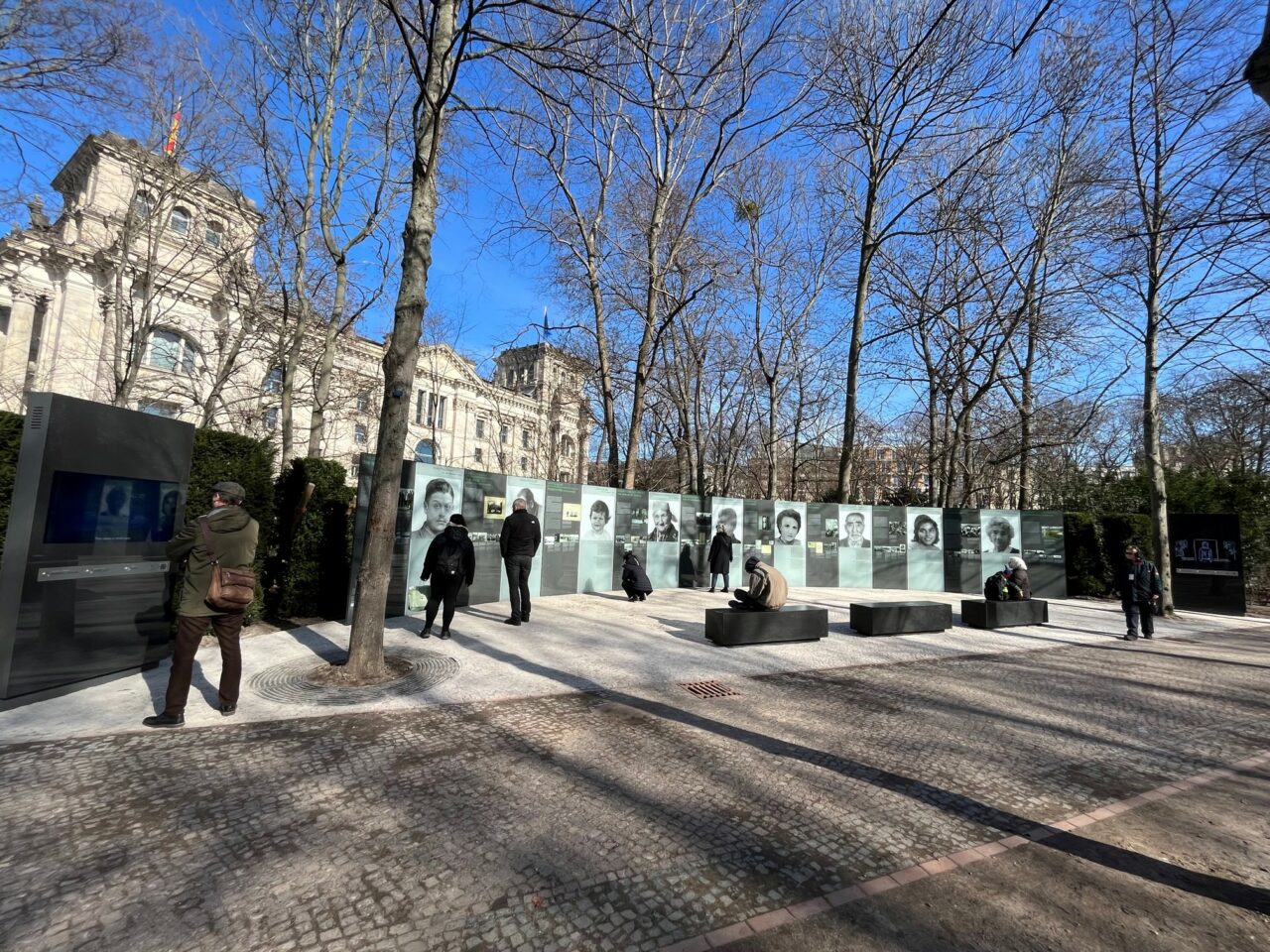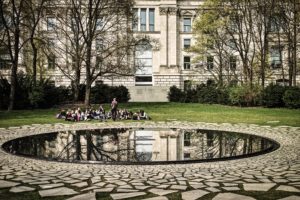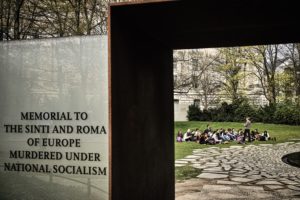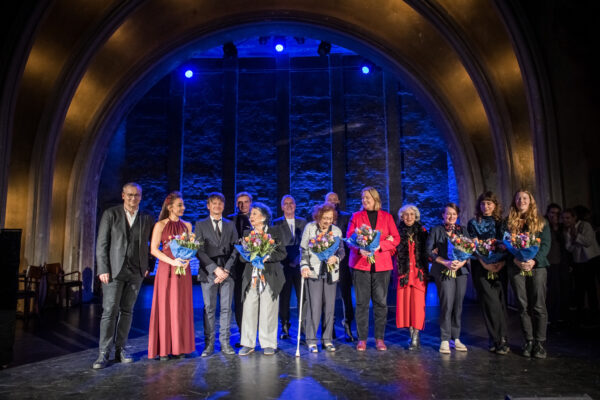Please note:
Due to the European Championship fan mile in the Tiergarten, access to the Memorial to the Sinti and Roma of Europe murdered under National Socialism is expected to be restricted until the end of July 2024. We ask for your understanding.
In 1992 the Federal Government decided to erect a national monument in memory of the murder of the European Sinti and Roma persecuted as “gypsies”. The memorial of the artist Dani Karavan consists of a fountain with a stone that can be lowered and on which a fresh flower is placed every day. In addition, panels provide information on exclusion and mass murder of this minority during the National Socialist reign of terror. The memorial was ceremoniously opened to the public on 24 October 2012.
Memorial
24 hours a day
accessible
PLACE
Simsonweg
10557 Berlin
CONTACT
+ 49 30 26 39 43 – 0
info@stiftung-denkmal.de
Architect Dani Karavan
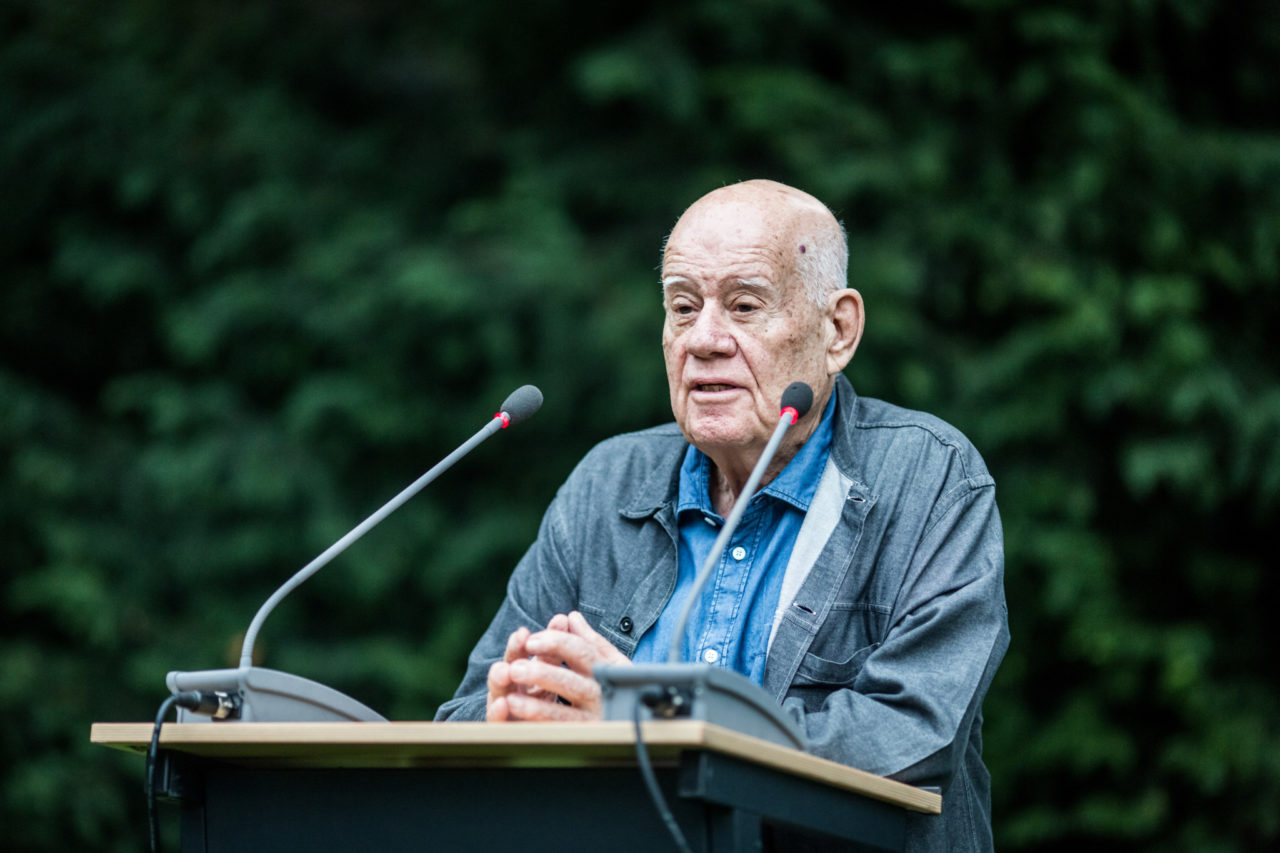
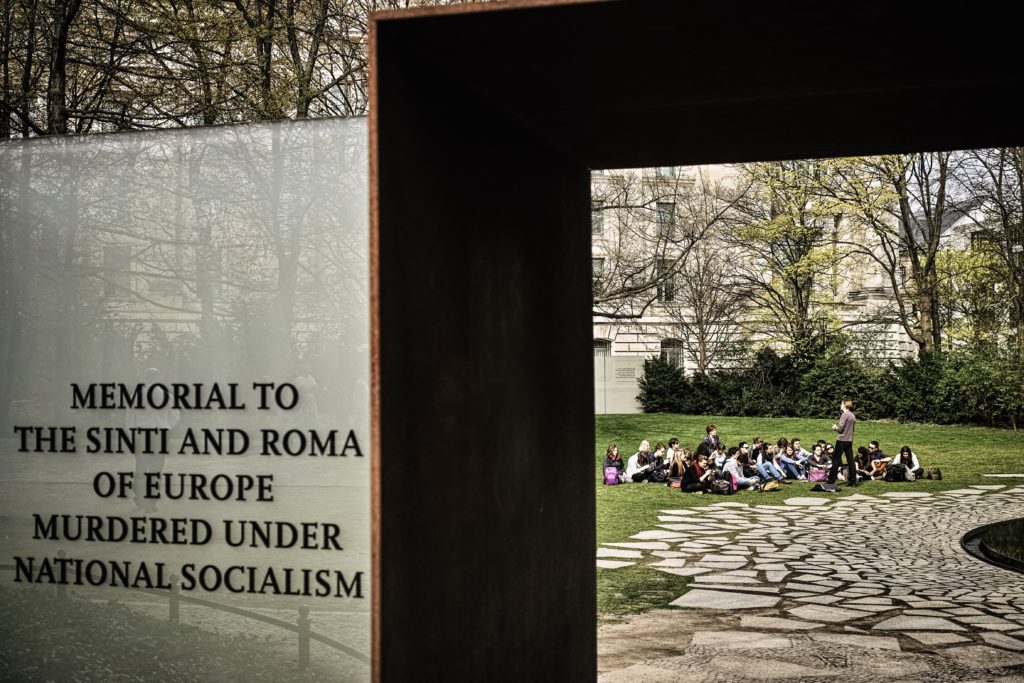
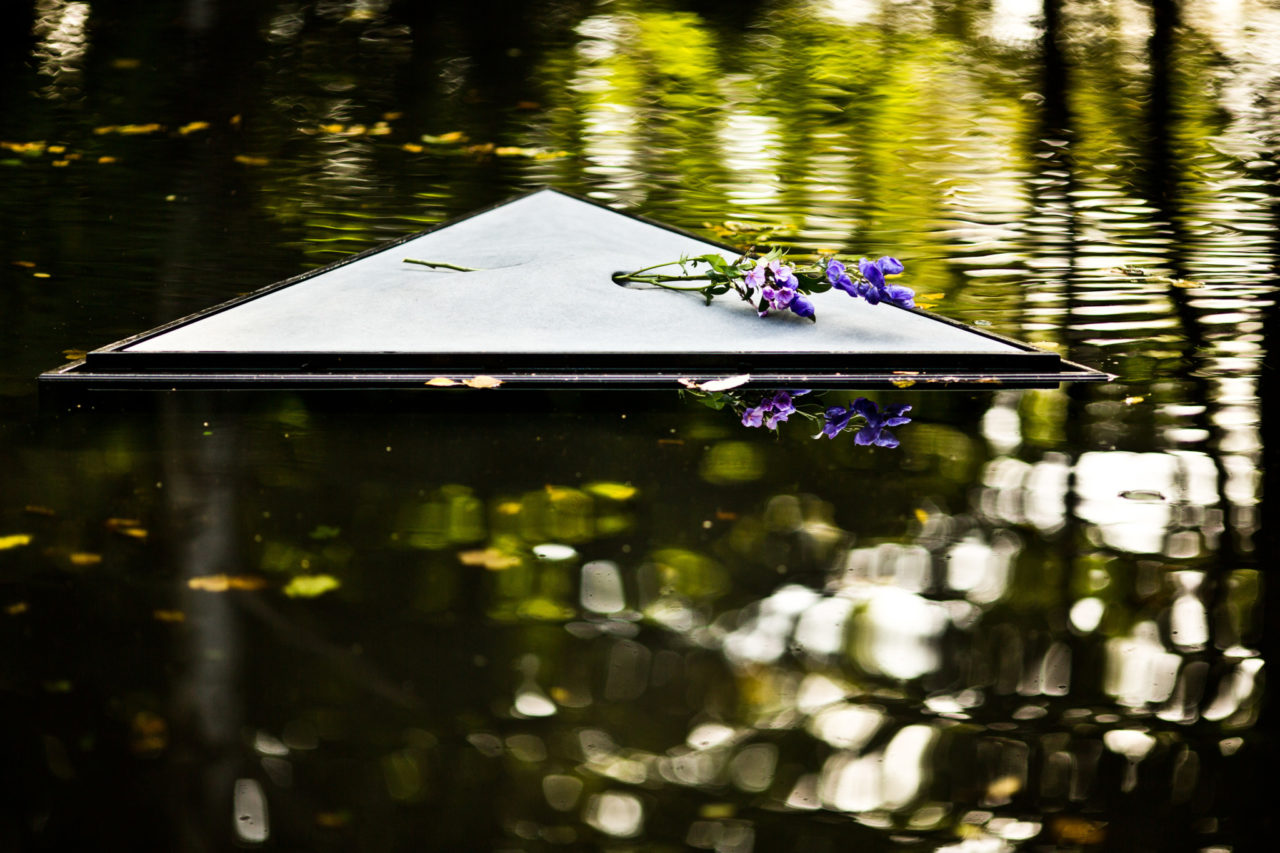
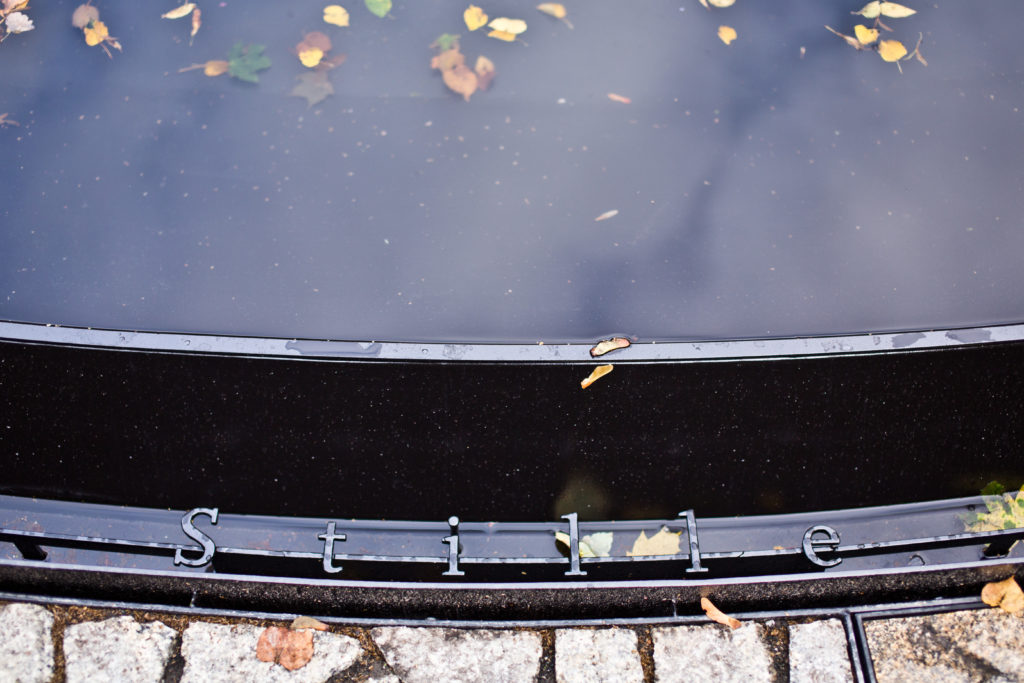
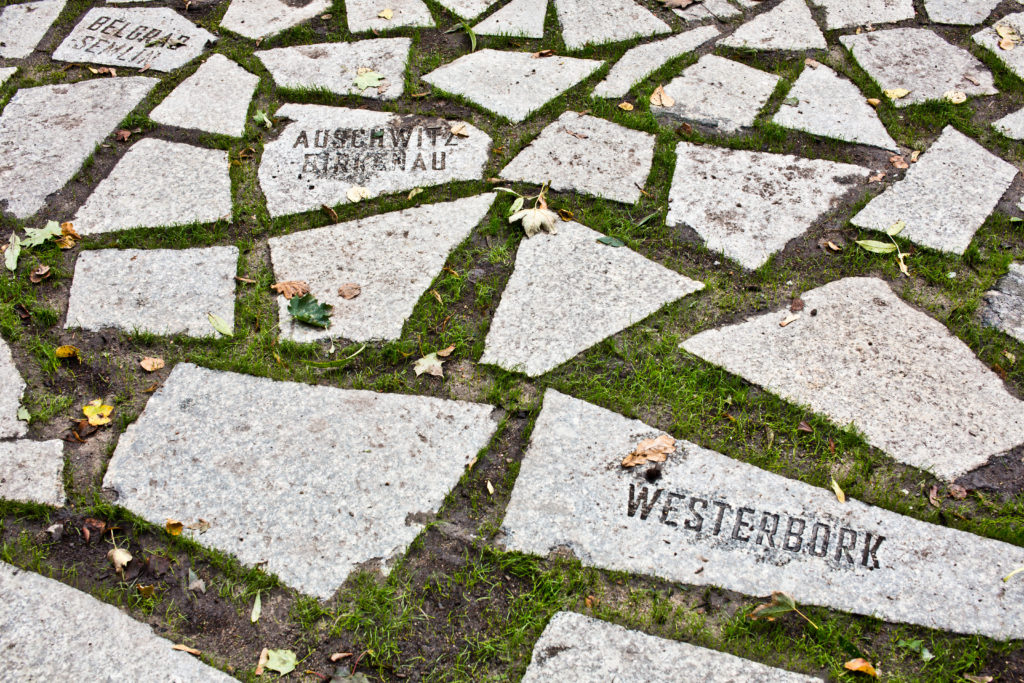
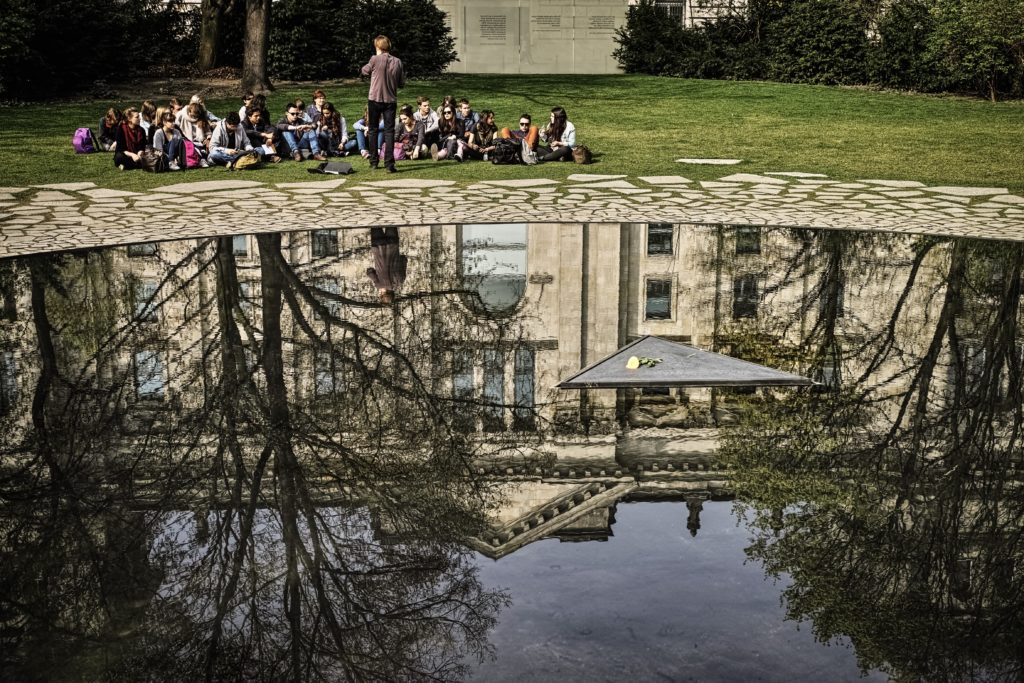
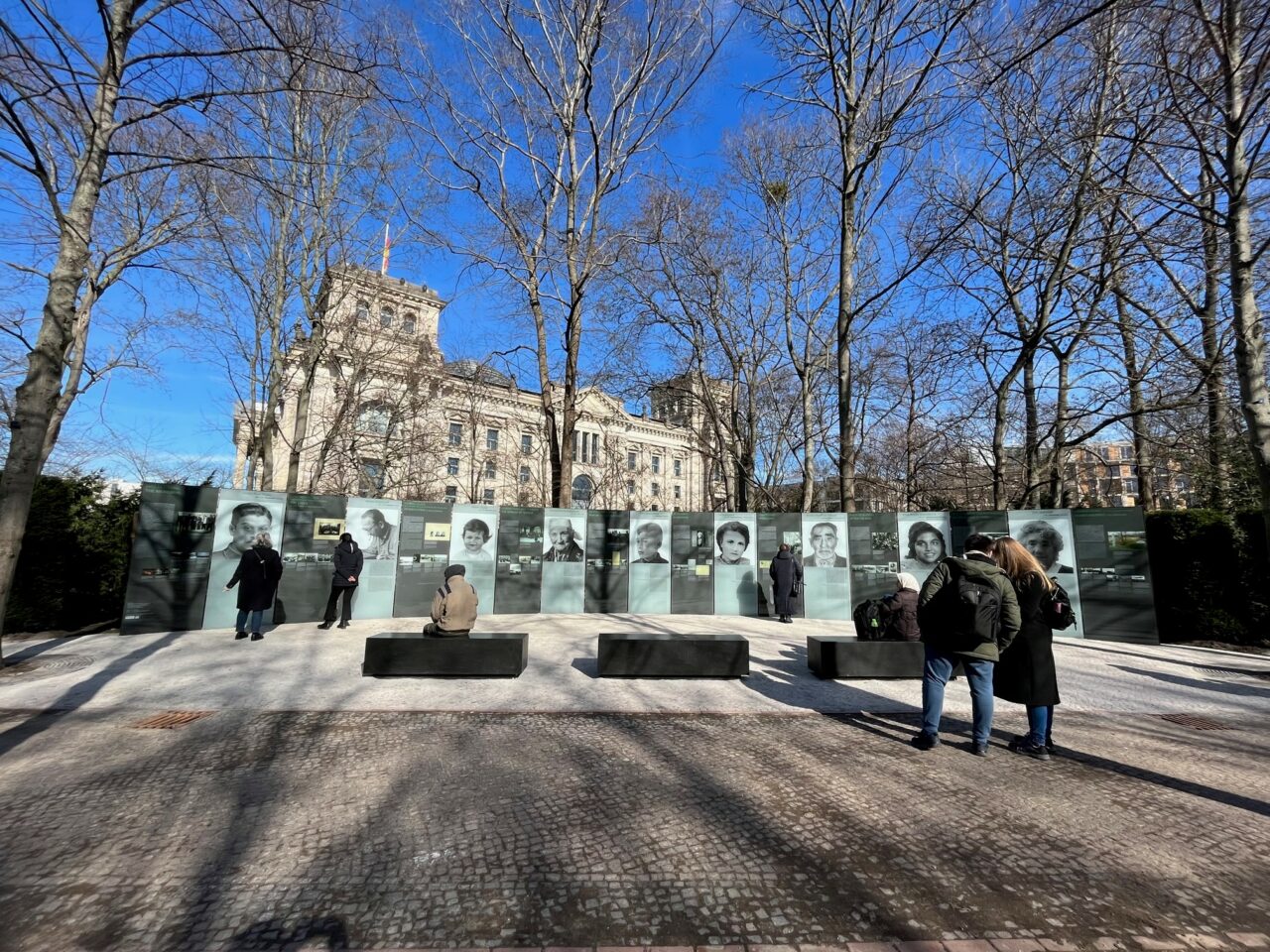
A clearing in the Tiergarten, lined with trees and bushes, near the Reichstag building. A small, inconspicuous place, which avoids the noise of the big city. A place of inner sympathy, a place to feel the pain, to remember and never let the destruction of the Sinti and Roma by the National Socialist regime fall into oblivion. Is such a place even possible? Is the possible the emptiness, the nothingness? Do I have the power within me to create a place of nothingness? Where there’s nothing. No words, no names, no metal, no stone. Only tears, only water, surrounded by the survivors, by those who remember what happened, by those who know horror and others who did not know it. They are all reflected here, standing on their heads, in the water of the deep, black pit, while the sky covers them – the water, the tears. Just a single little stone that sinks and rises, again and again, day after day. And on it every day a new little blossom to remember, to recall each time anew, incessantly, for all eternity. The water surrounds the sky, the blue sky, the grey sky, the black sky. The clouds, the light, the darkness. Everything is swallowed up by the swirling water. Only the sound of a lonely violin has remained of the murdered melody, floating in pain.
Dani Karavan was born on 7 December 1930 in Tel Aviv as the son of Polish Jewish immigrants. At the age of twelve he turned to painting and in 1943 received his first drawing lessons in Aharon Avni’s studio. He studied at the Bezalel School of Art and Design in Jerusalem, at the Accademia di Belle Arti in Florence and at the Académie de la Grande Chaumière in Paris.
Many of his works are dedicated to the memory of the Holocaust. He himself also loses part of his family during the Nazi reign of terror. In 1993 he completed the Way of Human Rights at the Germanisches Nationalmuseum in Nuremberg. In 1994, on behalf of the French state, he realised the Camp de Gurs, a national memorial against forgetting authentic places.
His works are often designed with natural materials such as water, sand and even wind. They invite the visitor not only to observe, but also to move and reflect on each individual element.
Open-air exhibition
At the centre of the open-air exhibition, which was added in October 2022, are the biographies of nine persecuted or murdered Roma and Sinti from different European contexts of origin. In addition, the exhibition presents the European dimension of the genocide, tells stories of resistance and depicts the arduous efforts of civil rights movements for recognition.
Animated short films on the nine biographies will be shown on media stations: Zoni Weisz (Netherlands), Zilli Schmidt (Germany), Lidija Krylova (Russia), Adam Ujvary (Austria), Matéo Maximoff (France), Vinko Paul Franz (Germany), Branko Branislav Acković (Serbia), Elina Emílie Holomková (Czech Republic) and Noncia Alfreda Markowska (Poland).
Shortfilms
Elements of the memorial
The metal frame of the water bowl contains the poem »Auschwitz« by the Italian Roma musician, composer and university teacher Santino Spinelli. In German and English, it lines the lake. On the fringes of the chronology, it can also be read in two different dialects of the Romanes.
Sunken in face
extinguished eyes
cold lips
silence
a torn heart
without breath
without words
no tears.
Poem of the Italian
Roma Santino Spinelli
Within the monument space created by glass walls and planting, music, an ever-changing violin tone, the piece »Mare Manuschenge« (»Our People«), composed by Romeo Franz, can be heard permanently. Romeo Franz also recorded it himself for the recording, which is permanently sounding at the memorial. The violin tone follows a minor tone conductor, which is at the foundation of the traditional music of the Sinti and is also characteristic in modern Sinti-Jazz and Sinti-Swing.
In the middle of the clearing lies a circular lake about twelve meters in diameter, consisting of a tub of dark coated steel. With the appropriate light, it reflects the visitors, the trees, the sky and also the mighty Reichstag building. According to Karavan’s idea, the impression should be created that the lake is infinitely deep.
From the middle of the lake rises a triangular granite base. According to Karavan, the triangle is a quote from the angular inmate markings in the camps. This pedestal sinks down to the depths every day at lunchtime and is brought back to the surface shortly afterwards with a fresh flower.
Roughly broken stone slabs are embedded in the lawn around the lake, whose shape is reminiscent of shards (destruction, fragmentation, loss, injury). Some of these plates contain the names of 69 places where extermination, concentration and collection sites were located, or where executions of Sinti and Roma took place.
History of the memorial
Under the rule of National Socialism, from 1933 to 1945, hundreds of thousands of people in Germany and other European countries were persecuted as “gypsies”. Most of them referred to themselves as Sinti, Roma, Lalleri, Lowara or Manusch, for example, according to their respective affiliations to different groups. The largest groups in Europe were the Sinti and Roma. The aim of the National Socialist state and its racial ideology was the annihilation of this minority: children, women and men were abducted, murdered in their hometowns or in ghettos, concentration camps and extermination camps. Members of the independent Jeni victim group and other travellers were also affected by persecution measures.
1933
Sinti and Roma are increasingly discriminated against, disenfranchised and excluded from social life. The first prisoners were admitted to concentration camps and forced sterilizations began in 1934. In 1935, forced camps were set up in many cities of the German Reich. Two weeks before the opening of the 1936 Olympic Games in Berlin,
hundreds of people are sent to such a camp in the Marzahn district. The camps are used for concentration, determination and registration, isolation and
recruitment to forced labour.
1936
According to the “Nürnberger Rassengesetze” (1935), the Minister of the Interior, Wilhelm Frick, decreed in January 1936: “All other breeds belong to the alien breeds; in Europe, apart from the Jews, these are regularly only the gypsies”. On this basis, a special racist right was established, which for those affected meant, among other things, marriage bans and exclusion from professions or the Wehrmacht.
1938
Over 2,000 Sinti and Roma from Germany and Austria, including children aged twelve and over, were deported to Dachau, Buchenwald, Sachsenhausen, Ravensbrück, Mauthausen and other concentration camps by 1939.
by 1939. On the instructions of the “Reichsführer SS und Chefs der deutschen Polizei”, Heinrich Himmler, a central office was set up at the Reichskriminalpolizeiamt in Berlin to control and coordinate the registration and prosecution
of Sinti and Roma. In December a fundamental decree of Himmler is issued “to tackle the regulation of the gypsy question from the essence of this race”
with the aim of the “final solution of the gypsy question”. The “Rassenhygienische Forschungsstelle” (racial-hygienic research centre) commissioned with the registration prepares almost 24,000 “racial expert reports” by the end of the war,
which form an essential basis for the deportations to extermination camps.
1939
With the beginning of the Second World War, the “Reichssicherheitshauptamt” (Reich Security Main Office), which was in charge of the organisation of the genocide, plans to deport all people registered as “gypsies”. In order to prepare for deportations, it ordered all those affected “to be obliged not to leave their place of residence or their current whereabouts until further notice”.
1940
On Himmler’s orders, entire families are deported from Germany to occupied Poland: “The first transport of gypsies after the Generalgouvernement will be set in motion in mid-May, with 2,500 people […].”. In camps, later also in ghettos, they had to perform forced labor under cruel conditions. In many places Sinti and Roma are subject to identification by special identity cards or armbands with the inscription “Z”.
1941
Systematic mass shootings of Roma begin in the occupied Soviet Union and in the other occupied territories of Eastern and Southeastern Europe. A “task force of the security police and the SS security service” from the Crimea reports: “Gypsy question cleared up”. About 5,000 Roma and Sinti from Burgenland in Austria are deported to the ghetto Litzmannstadt (Łódź) in occupied Poland – more than 600 of them die there. The survivors are murdered in January 1942 in the Kulmhof extermination camp (Chełmno) in gassing cars.
1942
After a discussion with Reich Minister of Propaganda Joseph Goebbels about the extradition of prisoners of justice to the SS, Reich Minister of Justice Otto Georg Thierack writes that “Jews and gypsies per se […] are to be destroyed. The idea of annihilation through work is “the best”.
1943
On the basis of a decree issued by Heinrich Himmler on 16 December 1942, the deportations of around 23,000 Sinti and Roma from almost all of Europe begin in February. The destination of the transports is a section of Auschwitz-Birkenau which the SS described as a “gypsy camp”. Within a few months, most of them died of hunger, epidemics or acts of violence by the SS. Numerous children fall victim to the experiments of the SS camp doctor there, Josef Mengele.
1944
On 16 May, many of the 6,000 prisoners still living in the “gypsy camp” in Auschwitz resisted their impending murder. About half of them are deported to other concentration camps for forced labour. The last 2,897 survivors – mostly children, women and old people – are murdered in the gas chambers during the night of August 2 to 3.
1945
The number of people persecuted as “gypsies” who fell victim to the genocide in the National Socialist domain will probably never be determined exactly. Estimates range up to 500,000 murdered men, women and children.
“The Sinti and Roma were seriously injured by the Nazi dictatorship. They were persecuted on racial grounds […]. These crimes have committed the crime of genocide.”
“The genocide of the Sinti and Roma was carried out for the same motive of racial madness, with the same intention and the same will to the planned and final annihilation as that at the Jews. They were murdered systematically and family-wise in the entire sphere of influence of the National Socialists, from infants to the elderly.”
On 24 October 2012, the inauguration ceremony of the Memorial to the Sinti and Roma of Europe murdered under National Socialism took place in Berlin. Besides Chancellor Dr. Angela Merkel, Federal President Joachim Gauck and Federal Parliament President Prof. Dr. Norbert Lammert took part in the ceremony on the edge of the Tiergarten opposite the Reichstag.
The individual speeches can be read here: Federal Chancellor Angela Merkel, Minister of State for Culture Bernd Neumann, Architect Dani Karavan, Chairman of the Central Council of German Sinti and Roma Romani Rose, Survivor Zoni Weisz.
On 24 October 2022, the Central Council of German Sinti and Roma and the Foundation Memorial to the Murdered Jews of Europe invited to the ceremony on the occasion of the tenth anniversary of the handover of the memorial to the public and the opening of the supplementary open-air exhibition. The new exhibition was curated by Stiftung Denkmal and realized according to an artistic design by Dani Karavan.
Publications on the memorial
Offers for visitors
Visitor numbers 2022
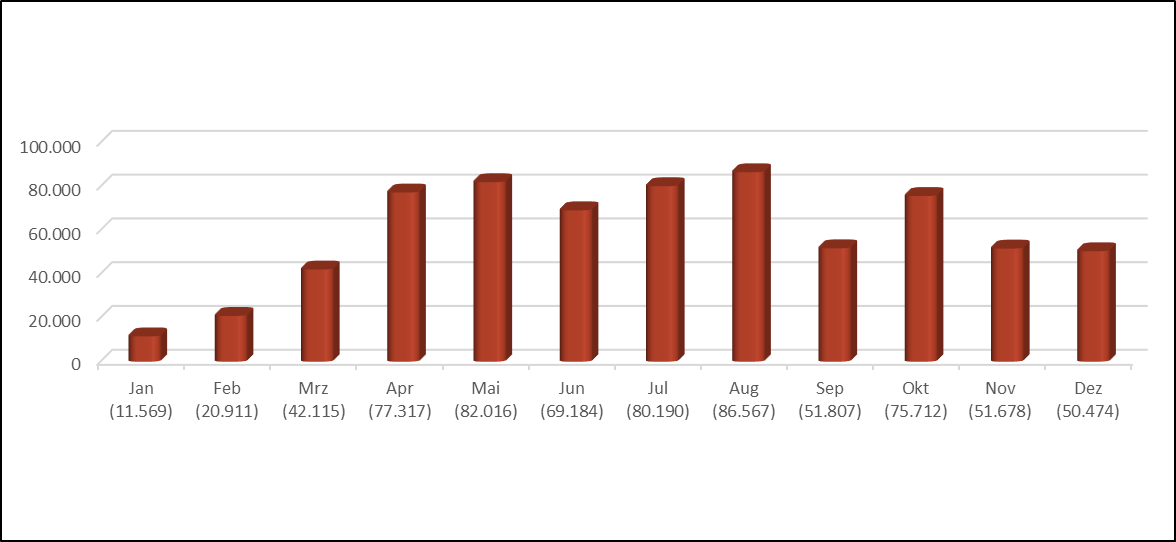
Initiatives and partners
Accessibility and visitor regulations
The memorial is freely accessible day and night. Access to the Memorial to the Sinti and Roma murdered under National Socialism is largely barrier-free.
Visitor regulations
- You are entering a place of remembrance. Please respect the cause and the people for whom this memorial was created.
- Please speak quietly.
- The black water level should reflect the sky, so please do not climb into the pool, throw coins or other objects into it.
- Also political demonstrations, flags or other symbols disturb the memory, as well as begging, smoking, grilling and the consumption of alcoholic beverages or any sporty activity.
- Visiting the monument is at your own risk all year round.
- Photographs or films taken for publication purposes may be approved by the Foundation Memorial to the Murdered Jews of Europe (presse@stiftung-denkmal.de).




